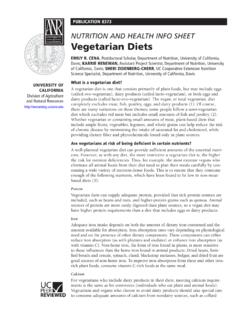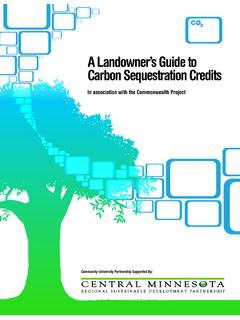Transcription of Rural Roads: A Construction and Maintenance Guide for ...
1 Rural Roads: A Construction and Maintenance Guide for California LandownersSUSAN D. KOCHER, UC Cooperative Extension Natural Resources Advisor, El Dorado County; JARED M. GERSTEIN, Staff Research Associate, Center for Forestry, University of California, Berkeley; and RICHARD R. HARRIS, UC Cooperative Extension Specialist, University of California, BerkeleyMany thousands of miles of privately maintained Rural roads extend throughout California, and they are used for resource management as well as residential and rec-reational access by over 500,000 landowners (fig. 1). The California Department of Forestry and Fire Protection (CAL FIRE) estimates that another million acres of forest and rangeland will be developed over the next 40 years, requiring the construc-tion of thousands of miles of new roads (CAL FIRE 2003). Poorly located, designed, or maintained roads are the primary cause of water quality degradation in Rural publication is designed to help Rural landowners understand how to improve and maintain existing roads.
2 It also provides guidance on planning new roads. It is written for people who have little to no previous experience in managing a road. If you have recently purchased a Rural parcel or have become responsible for road Maintenance on an existing parcel or otherwise feel unprepared for maintaining roads this publication should help you. It mainly addresses single-lane dirt or rock-surfaced Rural roads, also known as low-volume roads because they are not expected to carry high traffic publication should enable you to understand the basic principles of good road design and Maintenance recognize current and potential road erosion and drainage problems consider remedial treatments that may be needed develop rough estimates for the costs of road improvements and Maintenance communicate clearly with contractors who may perform work on your roadsPUBLICATION 8262 UNIVERSITY OF CALIFORNIAD ivision of Agriculture and Natural 1.
3 Low-volume road that has been newly grav-eled and out-sloped, San Bernardino County. Photo: Richard Harris. ANR Publication 8262 WH Y WO R R Y AB O U T RO A D DE S I G N A N D MA I N T E N A N C E?Road Maintenance should be considered an unavoidable neces-sity of living in a Rural area. landowners should take the time to learn about roads because when they are well designed and maintained they have fewer impacts on the environment, are more reliable, and cost less to maintain than problem impactsRural roads are a major source of sediment that ends up in stream channels (fig. 2). This is especially true for unpaved roads located near streams that are used year-round. Sediment delivered to streams from roads causes streams to run muddy and take a long time to clear after storms. Sediment can end up depositing in pools and adversely affect habitat for fish and other aquatic designed, located, or maintained roads have a higher risk of failing during storms than roads that are well constructed and maintained.
4 Adequately sized culverts, free-flowing ditches, and properly drained road surfaces are essential elements of a reliable road network. Without these elements in place, even a moderate winter storm can render a road of repetitive maintenanceThe bottom line is that it can be extremely expensive to main-tain roads that are designed, located, or constructed poorly. It is usually more cost effective to identify and remedy chronic road problems than to treat only the symptoms of the problem year after year. For example, it will cost less in the long run to install proper drainage structures and rock surfacing on a road that gets muddy and rutted every winter than to regrade the road surface every D E R S TA N D I N G RO A D CO M P O N E N T SAlthough roads vary in their configuration and design, they have common elements that affect their functionality and durability.
5 Roads must create a flat surface for vehicle travel on sloped land. To do this, part of the hillslope is cut away (the cut slope) and the removed soils are placed below (the fill slope) and compacted to create a flat bench or traveled way. This is called cut-and-fill Construction (fig. 3). A balanced cut-and-fill project uses all the cut material to generate the fill. In full-bench Construction , the cut is made wide enough to accommodate the entire traveled way (fig. 4). The cut mate-Figure 2. This cross drain delivers sediment from the roadside ditch under the road surface to a nearby stream. The road fill is also eroding. Photo: Jared slopeFillCutOriginal slopeFigure 3. Cut-and-fill road Construction design. Source: Kramer 4. Full-bench road Construction design. Source: Redrawn from Kramer 2001. ANR Publication 8262 rial is not used in the road Construction and must be hauled (end-hauled) to an off-site disposal area.
6 Full-bench Construction reduces the risk of fill slope failure but is usually more expensive due to hauling , a road should consist of three layers (fig. 5). The subgrade is the bottommost layer at the level of the in-place material. The base course is the main load-spreading layer and typically con-sists of gravels or gravelly soils, with sand and/or clay intermixed. The surface course or surfacing may consist of native materials, imported rock, or asphalt. It is placed on top of the base course to improve rider comfort, provide structural support, and weatherproof the road for wet season use. As a practical matter, many Rural roads are not con-structed in this way but consist entirely of native materials encountered during grading. This can be a factor contributing to poor roads must incorporate features to drain water off the road surface and allow it to cross from one side to the other.
7 Road drainage is the key to a road s integrity. Culverts are metal, concrete, or plastic pipes set beneath the road surface to drain ditches, springs, or streams crossed by the road. Culverts move water from the inside of the road (next to the cut slope) through a pipe to the outside of the road (to the fill slope or edge of bench). Ditches are used to collect water that accumulates from the road surface or hillslope on the inside or cut-slope side of an in-sloped road. Ditch relief culverts drain the accumulated water from the inside ditch to the outside of the culverts, common stream-crossing structures include bridges and low-water crossings or fords. Bridges usually cause fewer environmental impacts than cul-verts because they may not alter the natural channel form or require placement of fill in the channel. However, they are often more expensive to install than culverts.
8 Low-water fords involve modifying and sometimes hardening a swale or stream channel to allow vehicles to drive through during low-flow periods (figs. 6 and 7). Less fill is introduced to the stream channel; however, vehicles driving through may input sedi-ment to the stream continuously. Fords are typically impassable during high flows and so are rarely suitable for permanent cutFill slope(embankment)ShoulderCulvertTraveled waySurface courseBase courseSubgradeCut slope(Back slope)Figure 5. Components of a road. Source: Keller and Sherar 6. Low-water crossing on a perennial stream, San Bernardino County. Photo: Richard 7. Concreted low-water crossing placed on bedrock outcrop in intermittent stream. Photo: Angela Wilson, Central Valley Regional Water Quality Control Board. ANR Publication 8262 Rolling dips are constructed breaks in the road grade designed to drain water directly from the road surface to the outside of a road without using an inside ditch or ditch relief culvert (fig.)
9 8). They require vehicles to slow their speed of water bar is a mound of soil and an accompanying ditch on the road surface that interrupts water flow and diverts it off the road surface (fig. 9). It is typically not passable by vehicles and so is not used on permanent roads. A berm is a ridge of rock, soil, or asphalt usually found on the outside of a road shoulder to control surface water. It directs runoff to specific locations where water can be discharged without causing erosion. Armoring is the placement of a layer of rock on cut or fill slopes or ditches to prevent water from eroding the D E R S TA N D I N G RO A D DE S I G N A N D DR A I N A G EDraining water from the road surface quickly, without letting it concentrate, is key to preventing erosion and thus to maintaining a stable driving surface. Two characteris-tics influence how well water drains from the road surface: the steepness of the road ( its grade or gradient), and the shape and cross slope of the traveled way.
10 The gra-dient of the road is determined by its location and routing; thus, it cannot be changed without moving the road. The cross-sectional shape and slope of a road are the pri-mary design features that may be manipulated to improve with a gentle gradient are easiest to main-tain as long as the slope is adequate to drain the water off the road surface. In general, road grades need to be a minimum of two percent to facilitate drainage, so that water will not accumulate on the surface and saturate the subgrade. Saturated sub-grades in combination with repetitive splash ero-sion due to vehicle traffic are responsible for pot-holes and ruts (fig. 10). Steeper roads drain water more quickly, but this allows the water to develop more erosive power, necessitating measures to pre-vent erosion and 8. Rolling dips installed to drain an out-sloped road.















